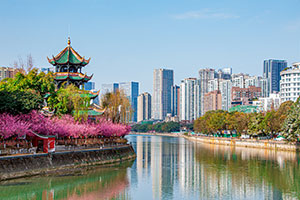Discover China’s past and present — from historic Beijing to the bustling metropolis of Shanghai. Visit the iconic Terra Cotta Warriors and giant pandas, and explore the storied Yangtze River on an all-balcony river cruiser.
Chongqing
Chongqing
Chongqing is a port city with the largest area and diverse population in China. It is a tourist attraction, commercial city, and focal point of the unique Yangtze Three Gorges tourist industry. Chongqing attracts visitors from home all over for its cultural heritage and tourist attractions. The city is starting point of the Yangtze River Cruise. Other attractions include Dazu Grottoes - valuable works of art carved during the ninth century. Visit Gold Buddhist Mountain, a rich repository of diverse animals and plants; there's Fishing Town - one of three ancient battlefields in China. Traveling in Chongqing allows savoring of delicious local food, such as Sichuan cuisine and world-famous hot pot dishes. Handicrafts made from bamboo have been enjoying great popularity among visitors. Chongqing's nickname as "Fog City" or "Furnace" is no exaggeration. The best time to visit Chongqing should be in spring, autumn and winter.
|
Destination Guide
|
Shanghai
Shanghai
Shanghai is a teeming metropolis of 11 million, bustling with energy, towering skyscrapers, art deco buildings, honking traffic, and shopping crowds. Once here, visitors will find Eastern ways abound: Tai Chi along the Bund, the serenity of exquisite ponds and gardens, and an endless flotilla of sampans edging along the Huangpu River. Explore Shanghai old and new: the busy bazaars and alleyways of the Old Town, Yu Garden, Wuxingting Tea House, Long Hua Temple and more.
|
Destination Guide
|
Yichang
Yichang
Located in the Hubei Province, in the east mouth of the Three Gorges, Yichang is called 'the throat of Chuan'. The city's history reaches back 7,000 to 8,000 years. The main attraction in the area however is the Three Gorges Dam, which is said to be one of the largest construction project in the history of man and the world's largest dam. Slated for completion in 2012, the dam will generate enough electricity to carry one-ninth of the country's total generated power. When the reservoir is filled, it will completely submerge two of the three famous gorges, along with the surrounding area. Needless to say, the enviromental and cultural impacts of this dam are highly controversial.
|
|
Chengdu
Chengdu
The main inland access city to Tibet, Chengdu is the capital of the "Heavenly State". Most known for its natural habitat and research center for giant pandas, this sprawling city boasts a population of over 11 million.
|
Destination Guide
|
Xi'an
Xi'an
Xi'an - with five million inhabitants and capital of Shaanxi Province - is one of the more pleasant of Chinese cities, more prosperous than any other city in inland China except Chengdu, with streets full of Japanese cars, stores flooded with temptations, and stylish locals in new discos. It's far richer than the surrounding area, a fact which becomes clear after a bus ride into surrounding plains. The city is also a primer in Chinese history, as between 1000 BC and 1000 AD it served as imperial capital for eleven dynasties. Find a wealth of important sites and relics hereabouts: Neolithic Banpo, the Terracotta Army of the Qin emperor, the Han and Tang imperial tombs, and in the city itself, the Goose Pagodas of the Tang, the Bell and Drum towers and Ming city walls, as well as two museums holding a treasury of relics from the most glamorous parts of Chinese history. The city is very popular with foreign residents, and many come to study, as the colleges are regarded as some of the best places to learn Chinese.
|
Destination Guide
|
Beijing
Beijing
Beijing is the country's economic, cultural and transportation center as well as a famous historical capital of China. Located in northwest North China Plain, Beijing is the second largest city in China with a population of more than 11 million and is ideal to visit all year. There are numerous museums and libraries with the largest collection of books in the country. It also serves as a center for science and technology. It is a hub of communications, with good railroad and air links with all parts of China and with major cities of the world, thus facilitating the rapid development of tourism as an important industry in Beijing. Beijing is an ancient city with a long cultural history. The four feudal dynasties--Jin, Yuan, Ming, and Qing had all set up their capital here and it became a most concentrated place of the country's scenic spots and historical sites. The best known are the Palace Museum, the Summer Palace, the Great Wall and the Temple of Heaven. Beijing aims to develop into a modern international metropolis..
|
Destination Guide
|






